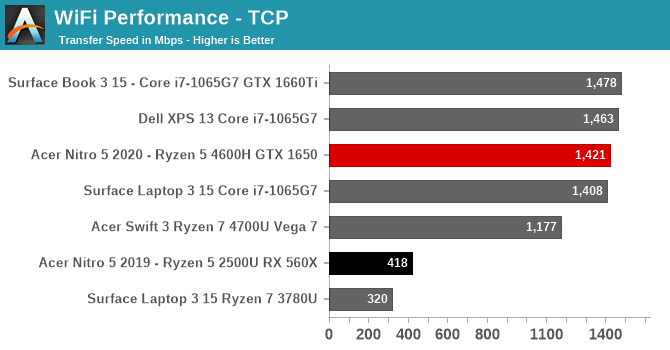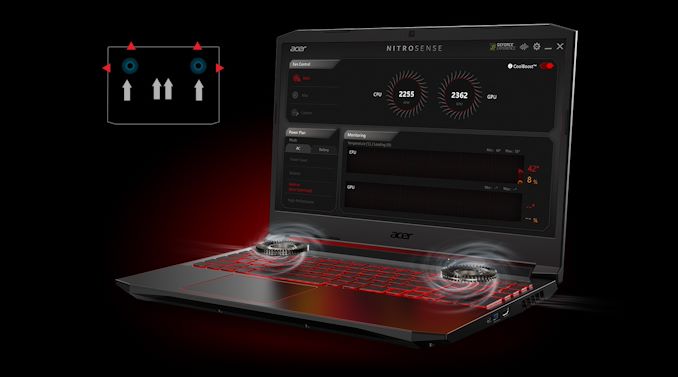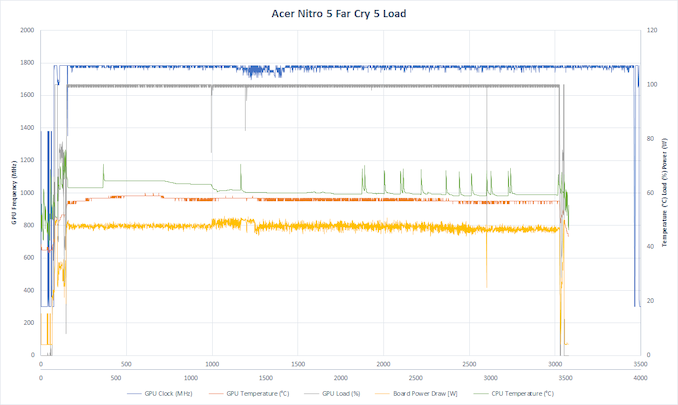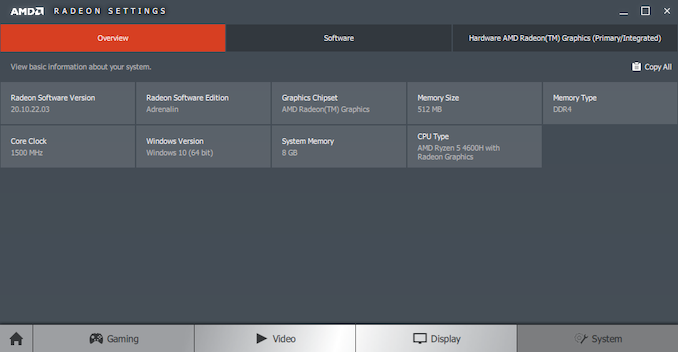The Acer Nitro 5 Review: Renoir And Turing On A Budget
by Brett Howse on October 9, 2020 8:00 AM ESTWireless
In a somewhat sad state of affairs, in the PC space there is really only one good wireless adapter, and that is Intel. Although there are a few competitors, they tend to not offer the reliability of the Intel drivers, nor the performance. Intel continues to improve their wireless products every year, to integrated them into their new laptop platforms, so Intel offers the most current standards as well. Despite being a budget system, Acer has outfitted the Nitro 5 with the Intel AX200 network card, which is a Wi-Fi 6 adapter offering 160 MHz channel support and all of the other accoutrements that go along with Wi-Fi 6.

For speed, it is as good as anything on the market, offering over 1.4 Gbps peak transfer rate on the 2x2 card. Reliability was perfect, with the laptop never waking without network, or randomly disconnecting. This years Intel wireless continues to improve on the company’s already large lead over the competition.
Audio
Acer’s Nitro 5 feautres dts:X Ultra audio processing, as well as two speakers firing downward at the front of the laptop.
The speakers themselves are below-average in terms of sound quality, with very little bass, even for a laptop. The stereo separation is excellent though, and the speakers get reasonably loud, hitting about 75 dB(A) measured 1-inch over the trackpad.
The dts:X software offers some nice functionality, with various pre-canned equalizer settings, as well as a graphical EQ option if you want to tweak it yourself. It is a simple, yet useful program, and is a nice inclusion.
Thermals
Cooling is a key component of a gaming system, as no one wants to have GPU temperatures spike during a long gaming session causing the GPU frequency to drop. The Acer Nitro 5, as a 15.6-inch laptop, is a mid-sized gaming system, but at 5.3 lbs and almost an inch thick, there is quite a bit of mass and space to facilitate cooling. Acer has intakes placed on the bottom, and four exhaust vents placed on the rear and side of the system. There are two fans, and their speed can be controlled via Acer’s NitroSense software which offers a CoolBoost option to increase the fan speeds for better cooling, at the expense of increased noise.
For our testing we left the fan speed set at auto, and enabled CoolBoost. At these settings, at idle the system was completely silent, but under load, noise was a factor with the system hitting about 53 dB(A) measured an inch over the trackpad.
To see how the system responded to load, first it was put under a CPU stress test using AIDA64.
There was some fluctuations in CPU frequency, although not out of what seems normal on Ryzen 4000, with the system hitting 4.0 GHz peak, and a maximum power draw of the SoC of 50 Watts. But once the system moved past its peak power draw, it settled in right on 35 Watts for the duration of the test.
To see how the system handles gaming loads, it was again loaded up with Far Cry 5 for a long gaming session, with the GPU and CPU temperatures logged, as well as other GPU metrics.
The result was about perfect, with almost flat lines across the graph. There was no reduction in performance even under 100% GPU load over long periods.
The noise levels were not excessive, although like most gaming laptops, under load it is loud enough that you would want to use closed-back headphones if possible. Overall, the cooling system was more than capable of handling the demands of the Ryzen 5 4600H and GTX 1650.
Software
As a low-cost system, it perhaps should not be a huge surprise that the Acer Nitro 5 comes loaded with not just system utilities, but also some software that is less than necessary. The system ships with a Norton Antivirus trial, along with several ad-generating notification systems and a couple of links pre-bookmarked in the browser. None of the software is too difficult to remove if you do not want it, but just be aware that it is there.
There is of course also the necessary utilities like Acer’s NitroSense already demonstrated above. Acer Care Center lets you check for device driver updates, and manage support, and works well.
Interestingly, there is the Killer Control Center, even though the default wireless adapter is the Intel AX200, so the Killer software is only there for the Ethernet connection.
It is also very interesting to see both the AMD Radeon Settings application and the NVIDIA GeForce software on the same system, but such is life when you have the Vega integrated GPU coupled with an NVIDIA discrete GPU.
Overall, there is too much software, too much bloat, and too many unwanted pop-ups when the system is first set up. It is generally a sign that Acer needs to increase the margins on the hardware, but with the entry-level price of this system, it is somewhat forgivable, although still not enjoyable for the end-user.

















50 Comments
View All Comments
cfenton - Friday, October 9, 2020 - link
The screen is such a big compromise on a laptop. I wish there was an option to pay a bit more and get something decent.I know it's kind of weird, but this looks like it would make a decent HTPC. It has lots of power and a new GPU for media playback.
ingwe - Friday, October 9, 2020 - link
Yeah this screen makes it DOA to me. Such a shame they cut that corner as it really separates a decent laptop from a great laptop.edzieba - Friday, October 9, 2020 - link
Seriously, 61% sRGB? How on earth do you even FIND an IPS display with primaries that far off?!Otritus - Friday, October 9, 2020 - link
I recall an entry level laptop with amd having a 38% sRGB 60hz 1080p 15.6 in screen. That's more inaccurate than not!meacupla - Friday, October 9, 2020 - link
Consumers need to realize that panel type ≠ inferred qualityVery high quality TN panels have good enough color reproduction, but still not great viewing angles.
Very poor quality IPS panels look like garbage, and look like garbage at any angle.
meacupla - Friday, October 9, 2020 - link
Just to be clear I don't mean to let Very poor quality TN panels off the hook either.Very poor TN panels have extremely awful color reproduction, but are also combined with atrocious viewing angles that invert colors inside of 50cm viewing distances.
So, as awful as this IPS panel is, it's still infinitely better than an equally very low cost/quality TN panel.
sonny73n - Saturday, October 10, 2020 - link
I just got an laptop for less than $780. To my surprise, its IPS display has no backlight leaks even in the dark. I won't mention the brand because some of you may start the politic bullshit but here's the specs:Ryzen 4700U, 16GB DDR4 RAM, 512GB PCIE SSD, 14" 1080p 100% sRGB display, fingerprint sensor on the power button and backlit keyboard.
The companies behind those brands that allowed to sell in the US must've thought that most consumers are pretty stupid - all their midrange and budget devices are garbage.
DiHydro - Sunday, October 11, 2020 - link
Toshibakmmatney - Friday, October 9, 2020 - link
I bought an Intel version of this laptop last year - paid $550, so it was the lowest end model and I'm certain had this same display. The screen isn't that bad - much better than other laptops I had looked at. In fact, I had originally purchased an HP budget gaming laptop on black Friday, but the TN screen was so horrible I had to return it. By comparison this screen was awesome. I'm real picky about screens - my normal driver is a Dell Mobile Precision with an expensive color calibrated display. This screen was not as good, but I have no problems with it.lightningz71 - Friday, October 9, 2020 - link
I wish that the 1650ti version was available for testing as well. I've seen a few comparison benchmarks online, but not as rigorously done as these.Also, it looks like the 4800h version with the 1650ti and improved screen might be a decent foundation for a long term machine. Being able to add a 2.5 inch ssd as a boot drive, and then get two fast NVME drives to raid together to hold the game files, you could have a convincing mobile machine for the new titles coming out for the next console generation. It would be able to keep up with the higher data throughput demands, have 8 real cores, and a similar amount of memory, just no ray tracing.